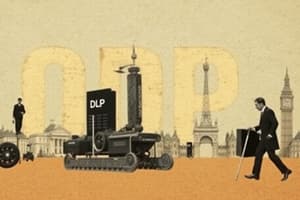Podcast
Questions and Answers
According to the Fisher equation, if the nominal interest rate is 7% and the real interest rate is 3%, what is the inflation rate?
According to the Fisher equation, if the nominal interest rate is 7% and the real interest rate is 3%, what is the inflation rate?
- 7%
- 3%
- 4% (correct)
- 10%
An increase in investor confidence will shift the supply curve in the loanable funds market to the right.
An increase in investor confidence will shift the supply curve in the loanable funds market to the right.
False (B)
Explain how secondary markets reduce the cost of borrowing for firms.
Explain how secondary markets reduce the cost of borrowing for firms.
Secondary markets provide liquidity, making securities more attractive to investors. This increased demand allows firms to borrow at lower interest rates.
Firms that help channel funds from savers to borrowers are known as financial ______.
Firms that help channel funds from savers to borrowers are known as financial ______.
Match the following bond grades with their risk level:
Match the following bond grades with their risk level:
Which type of unemployment is most closely associated with technological advancements rendering certain job skills obsolete?
Which type of unemployment is most closely associated with technological advancements rendering certain job skills obsolete?
The natural rate of unemployment includes cyclical unemployment.
The natural rate of unemployment includes cyclical unemployment.
What is the defining characteristic of 'full employment output' in terms of unemployment rates?
What is the defining characteristic of 'full employment output' in terms of unemployment rates?
When the economy experiences a recession, the unemployment rate is typically ______ the natural rate of unemployment.
When the economy experiences a recession, the unemployment rate is typically ______ the natural rate of unemployment.
U-6 unemployment includes which of the following, in addition to those who are unemployed?
U-6 unemployment includes which of the following, in addition to those who are unemployed?
Deflation refers to a period of increasing prices, indicating a positive inflation rate.
Deflation refers to a period of increasing prices, indicating a positive inflation rate.
Which of the following is a significant factor that introduces bias into the Consumer Price Index (CPI)?
Which of the following is a significant factor that introduces bias into the Consumer Price Index (CPI)?
Match the following terms with their descriptions:
Match the following terms with their descriptions:
Which of the following scenarios best illustrates the Rotunda Principle that 'trade creates value'?
Which of the following scenarios best illustrates the Rotunda Principle that 'trade creates value'?
A normative statement is an objective assertion about the way the world is.
A normative statement is an objective assertion about the way the world is.
Define 'ceteris paribus' and explain its importance in economic analysis.
Define 'ceteris paribus' and explain its importance in economic analysis.
_______ advantage occurs when an individual can produce a good or service at a lower opportunity cost than another individual.
_______ advantage occurs when an individual can produce a good or service at a lower opportunity cost than another individual.
Match each term with its correct definition:
Match each term with its correct definition:
According to Adam Smith's concept of the 'invisible hand', how are consumers guided to make choices that benefit society?
According to Adam Smith's concept of the 'invisible hand', how are consumers guided to make choices that benefit society?
A change in consumer income will cause a shift in the supply curve.
A change in consumer income will cause a shift in the supply curve.
Differentiate between a 'normal good' and an 'inferior good' in economics.
Differentiate between a 'normal good' and an 'inferior good' in economics.
The idea that resources are limited while wants are unlimited reflects the ________ vision.
The idea that resources are limited while wants are unlimited reflects the ________ vision.
Which of the following is the most accurate definition of Gross Domestic Product (GDP)?
Which of the following is the most accurate definition of Gross Domestic Product (GDP)?
Intermediate goods are directly included when calculating GDP to avoid double-counting.
Intermediate goods are directly included when calculating GDP to avoid double-counting.
Explain how to calculate Net Exports (NX) and its role in the GDP equation.
Explain how to calculate Net Exports (NX) and its role in the GDP equation.
Real GDP is calculated by dividing ________ GDP by the price level and then multiplying by 100.
Real GDP is calculated by dividing ________ GDP by the price level and then multiplying by 100.
Which of the following activities is LEAST likely to be accurately captured in GDP calculations?
Which of the following activities is LEAST likely to be accurately captured in GDP calculations?
Match each economic phase with its description:
Match each economic phase with its description:
Flashcards
Velocity of Money
Velocity of Money
The number of times a unit of money changes hands in a year.
Loanable Funds Market
Loanable Funds Market
The market where savers supply funds to borrowers.
Fisher Equation
Fisher Equation
Real interest rate = Nominal interest rate - Inflation rate.
Financial Intermediaries
Financial Intermediaries
Signup and view all the flashcards
Stocks
Stocks
Signup and view all the flashcards
Structural Unemployment
Structural Unemployment
Signup and view all the flashcards
Frictional Unemployment
Frictional Unemployment
Signup and view all the flashcards
Natural Unemployment
Natural Unemployment
Signup and view all the flashcards
Cyclical Unemployment
Cyclical Unemployment
Signup and view all the flashcards
Natural Rate of Unemployment
Natural Rate of Unemployment
Signup and view all the flashcards
Marginally Attached Workers
Marginally Attached Workers
Signup and view all the flashcards
Deflation
Deflation
Signup and view all the flashcards
CPI (Consumer Price Index)
CPI (Consumer Price Index)
Signup and view all the flashcards
Trade
Trade
Signup and view all the flashcards
Marginal Thinking
Marginal Thinking
Signup and view all the flashcards
Specialization
Specialization
Signup and view all the flashcards
Positive Statement
Positive Statement
Signup and view all the flashcards
Normative Statement
Normative Statement
Signup and view all the flashcards
Comparative Advantage
Comparative Advantage
Signup and view all the flashcards
Absolute Advantage
Absolute Advantage
Signup and view all the flashcards
Investment
Investment
Signup and view all the flashcards
Invisible Hand
Invisible Hand
Signup and view all the flashcards
Monopoly
Monopoly
Signup and view all the flashcards
Normal Good
Normal Good
Signup and view all the flashcards
GDP
GDP
Signup and view all the flashcards
Real GDP
Real GDP
Signup and view all the flashcards
Economic Expansion
Economic Expansion
Signup and view all the flashcards
Unemployment Rate
Unemployment Rate
Signup and view all the flashcards
Study Notes
- Rotunda Principles state that trade creates value and incentives affect behavior.
Trade
- Trade involves the voluntary exchange between two or more parties.
- Trade helps both sides, creates value, a positive-sum game, and encourages diverse interactions.
- Jonathan Sacks stated, "It is through trade that a difference becomes a blessing, not a curse."
Five Foundations of Economics
- Incentives
- Trade-offs
- Opportunity cost
- Marginal thinking
- Trade creates value
Factors in Trade
- Marginal thinking evaluates whether the benefit of one more unit of something is greater than its cost.
- A circular flow diagram shows how goods, services, and resources flow through the economy via commerce between households and firms.
- Endogenous factors are those we can control.
- Exogenous factors are those we cannot control.
Specialization, Statements and Ceteris Paribus
- Specialization limits one's work to a particular area.
- A positive statement describes what is.
- A normative statement describes what ought to be.
- Ceteris paribus refers to changing one variable without shifting any others.
Why Trade is Beneficial
- Comparative advantage: an individual or business produces at a lower opportunity cost than a competitor; it's why trade occurs.
- Absolute advantage: producing more than a competitor with the same quantity of resources.
- Gains from trade occur if each competitor specializes in a specific good, and trade can operate above the PPC curve.
Comparative Advantage Example with Pizza and Wings
- Gwen can produce 1 pizza for 2 wings (.5), while Blake produces 1 pizza for 3 wings (.33).
- Gwen producing pizzas and Blake producing wings is due to comparative advantage.
- It would be advantageous to trade at a ratio like 19 pizzas for 47 wings (.4).
- If the trade ratio doesn't fall between these two ratios, one side would decline.
Differentiating the Market
- Consumer good: any good produced for present consumption (e.g., shirt).
- Capital good: any good that helps in the production of other goods or services in the future (e.g., truck, factories).
- Investment: the process of using resources to create or buy new capital.
How the Market Operates
- Invisible hand: consumers are motivated by self-interest and guided to the goods they need or want most, setting the market in society's best interest (Adam Smith).
- Competitive market: producers and consumers each have a negligible impact on market price and quantity.
- Market power: A firm's ability to influence the price of a good or service by exercising control over demand and supply.
- Monopoly: a single company controls a market.
Supply & Demand
- Price is the only thing that can change quantity demanded.
- Demand schedule: a table showing the relationship between the price of a good and the quantity demanded.
- Market demand: the sum of all individual quantities demanded by each buyer in a market.
- Purchasing power: how much you can afford.
- Normal good: demand increases when income increases; inferior good is opposite.
- Remember shortages and surpluses, complements and substitutes.
Economic Theories
- Unconstrained Vision: We have sufficient resources to satisfy everyone.
- Constrained Vision: We have limited resources with unlimited wants at any point in time.
Measuring a National Economy
- GDP = Output = Income
- GDP: market value of all final goods and services produced within a nation during a specific period.
- When GDP rises, national output and income are higher.
- Real GDP is GDP adjusted for inflation.
- Economic growth: the percentage change in real per capita GDP.
- Recession: short-term economic downturn.
- Business cycle: a short-run fluctuation in economic activity.
- Economic expansion: from the bottom of a trough to its next peak (economic activity is increasing).
- Economic contraction: from top of a peak to its next trough (activity decreases).
- Economic growth is the percent change in real GDP per capita.
Details of GDP
- Intermediate goods: price not counted in GDP; goods that firms repackage/bundle with other goods to sell later.
- Final goods: price counted in GDP; what is actually sold.
- GNP: measure of national input; e.g., Nike shoes in Thailand included in U.S. GNP.
- Resold items, stocks, and bonds do not count toward GDP.
- GDP = C + I + G + NX
The Components of U.S. GDP
- Personal consumption expenditures (C): household expenditures for durable and nondurable consumer goods/services ($13.88 trillion).
- Gross private investment (I): business expenditures for capital goods, household purchases of homes, and inventories ($3.58 trillion).
- Government purchases (G): government expenditures for goods and services that the government consumes in providing public goods and for public capital ($3.50 trillion).
- Exports (X): goods or services produced domestically but sold abroad ($2.57 trillion).
- Imports (M): goods or services produced abroad but sold domestically ($3.12 trillion). NX = Exports - Imports = $-0.55 Trillion
Calculating GDP
- Nominal GDP is GDP calculated from current prices.
- Price level is an index of the average prices of goods and services in an economy.
- GDP Deflator is the price level in GDP data.
- Real GDP = (Nominal GDP / Price level) x 100
Trends and Shortcomings in Using GDP
- Nonmarket activities (e.g., work done at home) provide shortcomings in GDP measurement.
- The underground economy (narcotics, gambling) is not accounted for in GDP.
- The underground economy can account for up to 40% of the economy in underdeveloped countries.
- Per capita GDP positively correlates with many human welfare outcomes nearly everyone finds desirable.
- South Korea GDP = 14th in world
- South Korea per capita GDP = $34k
- (Nom GDP / Price level for that year) x 100 = adjusted price
Unemployment
- Unemployment occurs when a worker is searching for a job but is unsuccessful.
- The unemployment rate is the percentage of the labor force that is unemployed.
- Creative destruction is introducing new jobs/products and erasing others.
- Labor force participation rate: (Employed + Unemployed actively seeking) / Relevant population.
- Structural unemployment: jobs become obsolete from creative destruction or changes in the industrial makeup of the economy.
- Frictional unemployment: delays in matching jobs and workers (affected by information availability and government policies).
- Natural unemployment: there's always some; it's only structural and frictional.
- Unemployment insurance guarantees unemployed workers receive a percentage of their former pay while unemployed.
- Cyclical unemployment: caused by economic downturns, generates greatest concern.
- Natural rate of unemployment: the rate of unemployment when the economy normally grows is around 4-5% in the U.S.
- Full employment output (Y*) occurs when the natural rate of unemployment equals the unemployment rate (no cyclical unemployment).
- When the economy is in a recession, unemployment rises above natural unemployment (u > u*).
- Unemployment rate or u = (number unemployed/labor force) x 100
- Marginally attached workers looked for a job in the last twelve months and are willing to work, but haven't sought a job in the last four weeks.
- U-3 Unemployment is unemployed over the labor force.
- U-6 unemployment adds marginally attached individuals plus anyone working part-time who would work full-time if they could.
- RECESSION: u > u* and y < y*
Inflation
-
Deflation occurs when prices fall, resulting in negative inflation.
-
CPI measures the price level based on the consumption patterns of a typical consumer, measuring inflation. basket price price index = ----------------------------------------- x 100 basket price in base year
-
Price index shows growth
price level today
price in today's dollars = price in earlier time x ------------------------------------ price level in earlier time
- Factors that can affect CPI: substitution, changes in quality, and new goods/services/locations.
- CPI accuracy affects workers or companies negatively.
- Chained CPI reduces the upward bias of CPI by updating monthly.
- Shoe-leather costs are resources wasted when people change behavior to avoid holding onto money.
- Money illusion happens when people interpret changes in wages or prices as real changes.
- Menu costs are the costs of changing prices.
- Capital tax gains are the gains created by selling a product for more than its price.
- Inflation and money supply growth are positively correlated.
- The equation of exchange shows the long-run relationship between price level and quantity of money: (M x V) = (P x Y).
- Price level is the average price of goods/services in an economy at a specific time and a key indicator of inflation, consumer spending power, and the supply-demand chain.
- Velocity of money counts how many times a unit of money exchanges hands over a given year. %ΔΜ + %∆V ≈ %ΔΡ + %ΔΥ
ALL THE FINANCIAL STUFF
- Loanable Funds Market: borrowers and savers supplying funds to borrowers.
- Every dollar borrowed requires a dollar saved.
- Interest rate = opportunity cost of consumption.
- Profit-maximizing firms only borrow money if their expected return is greater than the cost.
- Fisher equation: Real interest rate = Nominal interest rate – Inflation rate or R = r + i
Shifters of Supply in the Loanable Funds Market
- Income and wealth
- Time preferences
- Consumption smoothing
Shifters of Demand in the Loanable Funds Market
- Productivity of capital
- Investor confidence
- Government borrowing
- Equilibrium occurs when savings = investments
SECURITIES AND FINANCIAL MARKETS
- Financial intermediaries: firms that help channel funds from savers to borrowers.
- Banks: private firms that accept deposits and extend firms.
- Indirect finance: savers lend money to financial intermediaries, who then loan the money to borrowers (banks).
- Direct finance: savers lend money directly to borrowers (stocks and bonds).
- Security: a contract that entitles its owner to certain rights (tradeable).
- Bond represents a type of security, representing a debt to be paid.
- Default risk and interest rates are aligned: higher the risk, higher the interest rate.
- All bond grades below BB are denoted “junk bonds.”
- Bond grades of AAA are the best, such as Harvard or Apple.
- Stocks represent ownership shares in a firm.
- Secondary markets are valuable for firms as they lower the cost of borrowing.
- Treasury securities are bonds sold by the national government to pay for the national debt.
- Securitization is creating a new security by combining otherwise separate loan agreements.
Studying That Suits You
Use AI to generate personalized quizzes and flashcards to suit your learning preferences.




